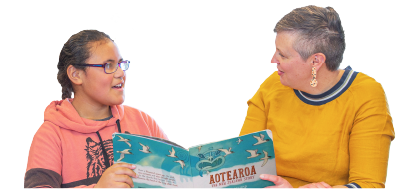Being a Cook Islander
Show video transcript
Title slide: Being Cook Islander
Exterior of the centre
Tapaeru Tereora, Founder Te Punanga o Te Reo Kuki Airani, Wellington, Cook Island Mama, facing camera
I love the weaving and I suppose to be having some flax you know to weave and all that. It’s part of our culture not only the language you know there’s our art and for the children to learn you know that's part of it.
Crystal Tutapakore, Guidance Counselor, Manurewa High School, Auckland, facing camera
I think one thing that teachers need to keep in the back of their minds is that not all brown people are the same. So. Yep, some of us are from Samoa, some of us are from Tonga, some of us are from the Cook Islands. But even in that, there's still little minorities, say the Cook Islanders. There's 15 islands. Rarotonga is different to Aitutaki. Aitutaki is different to Mangaia. Mangaia is different to Palmerston. You know, so just understanding that not every brown person is the same. Like, even though when the kids or when we come in through those doors we're not all just that label of a ‘brown person’ like you know there's more behind us than what presents and what the eye sees.
Student Leader, Manurewa High School, Auckland
Students dancing
Being Samoan and Cook Island, my family, as one, we like to keep it equal so we learn about both things on each side.
Student Leader, Manurewa High School, Auckland, facing camera
Being able to learn the backgrounds of my family especially going through back in the days when um like, we have chief families. So, like for me, that’s something important to me cause I am able to carry that around with me, especially through my last name, and being able to express both sides of my cultures - yeah.
Jemiah Teariki, Student, Kelston Boys’ College, Auckland
For the flag there’s 15 stars and all those stars stand for each island. So from those 15 stars, 15 islands I’m from seven of them. So three for my mum and four for my dad, so they’re both Cook Island. My mum, she is Mangaia atiu, whereas my grandpa, he knows how to speak the lingo the language but due to the 15 islands there’s 15 different dialects so slightly, say on Raro um ‘kare’ which means ‘no’ and then probably in another dialect it will be completely opposite.
Johnny, Student Leader, Manurewa High School, Auckland, facing camera
I’m happy to be Cook Island because it’s a unique culture and mostly people don’t really know how, how good we are and like how our culture goes, like you mostly see Samoan, Tongans and like, when I look at my culture and it makes me proud just to think that like my culture is like, you know sad that my culture is not out there that much, like Tongan and Samoan, but when, just, but I’m happy to be Cook Island and Cook Island until the day I die and evermore.
Tapaeru Tereora, Founder Te Punanga o Te Reo Kuki Airani, Wellington, Cook Island Mama, facing camera
I think we as parents have to be at the background of the child. To encourage them to carry on, of what they want to do.
This video is about being Cook Islander and is also about the diversity of Pacific Islands and how one size does not fit all. In the Cook Islands, there are 15 islands as represented by the stars on their national flag. Each small island that belongs to the main island has its own distinct dialect. For some people, their identity can be traced to many islands. Cook Island culture is expressed through self-identity. Self-identity includes representing the island(s) you are from and your family name. One participant speaks about being proud to be a Cook Islander and how the Cook Island culture is not as highly visible when compared to Samoa or Tonga.
Reflections for individual teachers
As you watch this video, think about the Cook Island learners in your classroom and reflect on your own self-identity.
- As your Cook Island learners walk through the school gate ask them if they see part of themselves reflected in the school environment and classrooms.
- How can you support your Cook island learners to respond well and participate in a variety of learning situations? How can you identify priorities for their learning? How can you support their culture, language, and identity to ensure that your Cook Island learners get an effective education?
- What support and resources do you need to assist you with improving learning outcomes for your Cook island learners? How will support and resources inform curriculum activities?
- How will you engage with Cook Island parents and families in making decisions about their child's learning? Will it be a different approach from other island groups? If so, how?
Reflections for staff or departments
As you watch this video as a staff member or member of a department team, think about how your school is meeting the needs of your Cook Island learners.
- How has your school built on the teachers’ knowledge of Cook Island culture to meet the needs of your Cook Island learners?
- Think about ways your school can challenge your teaching staff to look at a curriculum area of their choice and how they can incorporate the Te Reo Māori Kuki Aiani and culture into it.
- Think of examples of appropriate contexts for Te Reo Māori Kuki Aiani and culture, and any improvements to school systems and processes you have made to develop a rich classroom environment and more appropriate contexts for learning for Cook Island learners.
- Ask your staff to walk around the school and classroom environments to see if they can identify Cook Island artifacts, displays of Cook Island language and culture, and any other resources that relate to Cook Island learners in your school.


